Traditional Poster
Image Recon / Motion Correction / AI
ISMRM & ISMRT Annual Meeting & Exhibition • 10-15 May 2025 • Honolulu, Hawai'i

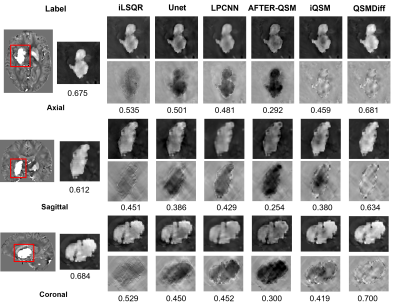 |
5121. Rapid
Quantitative Susceptibility Mapping for Intracranial Hemorrhage
using Deep Learning-based 2.5D Diffusion Models
Z. Xiong, Y. Gao, W. Jiang, K. Butcher, A. Wilman, H. Sun
University of Queensland, Brisbane, Australia
Impact: This reliability across imaging conditions
highlights QSMDiff’s potential as a versatile and accurate
tool for clinical susceptibility mapping for ICH patients.
|
|
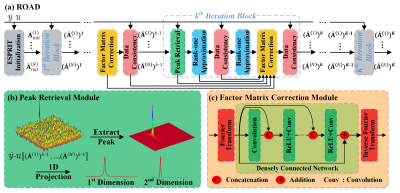 |
5122. Rank-One-Approximated
Decomposition for N-dimensional NMR Spectroscopy Reconstruction
with Physical Intelligent Neural Network
Y. Huang, Y. Gao, D. Guo, V. Orekhov, T. Agback, X. Qu
Xiamen University, Xiamen, China
Impact:
Designed by fast low-rank approximation, neural network correction and peak retrieval, ROAD shows the robust reconstruction benefited from optimization and fast computation from deep learning. Instead of reconstructing high-dimensional signals directly, ROAD reconstructs signals in each dimension with high efficiency. |
|
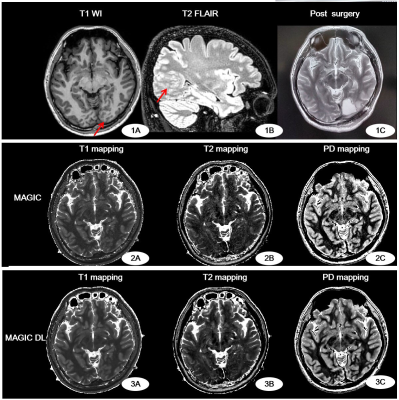 |
5123. Evaluation
of Deep learning-based reconstruction synthetic magnetic
resonance imaging MAGIC
J. Wang, H. Xu, Y. Hou, B. Xu, J. Lu
Xuanwu Hospital Capital Medical University, Beijing, China
Impact: The utilization of deep learning-based image
reconstruction techniques in MAGIC image not only provide
high quality images, but also underscore the potential of
the MAGIC DL methodology as an alternative tool to detect
lesions in pathology studies.
|
|
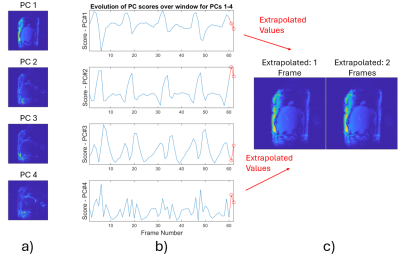 |
5124. Predictive
Imaging Methodology for Real-Time MRI-guided Radiotherapy
G. Han, M. Wright, E. Yip, B. G. Fallone, J. Yun, K.
Wachowicz
University of Alberta, Edmonton, Canada
Impact: Prediction of images beyond the current
real-time image will allow a simple and accurate means of
controlling beam position, overcoming issues with equipment
lag. Because this work does not rely on prior
characterizations, it is potentially robust against
non-cyclic motions.
|
|
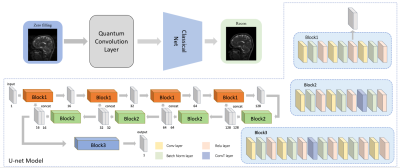 |
5125. Accelerated
Magnetic Resonance Imaging via Quantum Computing and Deep Neural
Network
S. Zhou, Y. Zhou, C. Liu, Y. Zhu, H. Zheng, D. Liang, H.
Wang
Shenzhen Institute of Advanced Technology,Chinese Academy of Sciences, Shenzhen, China
Impact: This fully demonstrates the potential and broad
development prospects of quantum computing in accelerating
magnetic resonance imaging.
|
|
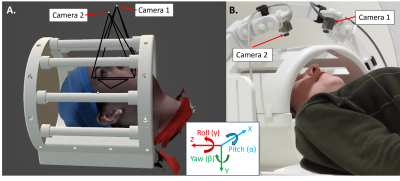 |
5126. Accurate,
markerless optical tracking of head pose for motion correction:
A dual-camera simulation with deep learning
M. Silic, S. Graham
University of Toronto, Toronto, Canada
Impact: Accurate, markerless OT is feasible in
simulations with two in-bore cameras and deep learning.
Pre-training of a twin neural network was successful (mean
RMSE = 0.13 mm/degrees) motivating additional development in
the real world, towards motion correction in MRI.
|
|
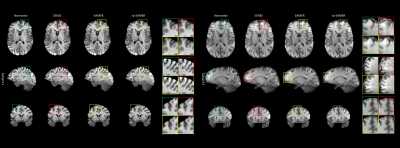 |
5127. Retrospective
Motion Correction at Ultra-High Field using SAMER and Reflected
Power
Y. HUANG, D. Polak, T. Yu, A. Klauser, N. Montemayor, J.
Philippe, E. Sleight, T. Kober, D. Popp, D. N. Splitthoff,
H. Tan, G. F. Piredda, T. Hilbert
Siemens Shenzhen Magnetic Resonance Ltd, Shenzhen, China
Impact: Retrospectively reducing motion artifacts in
ultra-high field scans enhances diagnostic usefulness,
especially for high-resolution acquisitions to detect small
focal pathology, a typical clinical use case of ultra-high
field scanners.
|
|
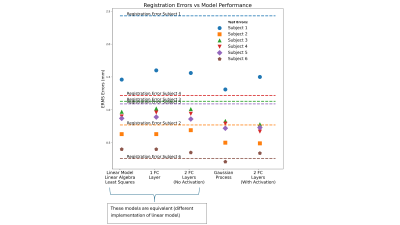 |
5128. Rigid
Body Head Tracking with Scattering: A Comparison of Linear,
Gaussian Process and Deep Learning Models
H. Simmons, J. Kent, M. Nadar, M. Mostapha, J. Tanner, A.
Hess
Wellcome Centre for Integrative Neuroimaging, FMRIB, Nuffield Department of Clinical Neurosciences, University of Oxford, Oxford, United Kingdom
Impact: We have shown that Gaussian Process and simple
deep learning models can outperform the existing linear
models for tracking head pose with scattering on a single
subject. This could be valuable in the future for
applications to motion correction.
|
|
 |
5129. Clinical
evaluation of motion-corrected 2D axial T2-weighted turbo spin
echo 3T brain MRI in the neurological intensive care unit
A. Hajati, C-H Chiang, S. Yee, A. Tabari, D. Polak, D.
Splithoff, B. Clifford, W-C Lo, Y. T. Huang, S. Cauley, J.
Conklin, S. Huang
Athinoula A. Martinos Center for Biomedical Imaging, Massachusetts General Hospital, Harvard Medical School, Charlestown, United States
Impact: SAMER effectively corrects for motion and
enhances the diagnostic quality of axial T2 TSE brain MRI in
motion-prone, critically ill patients, supporting its
utility for more accurate, timely assessments in
neurologically compromised individuals.
|
|
 |
5130. Rigid
and multirigid motion-mitigated MRI with self-gated Cartesian
acquisition
Z. Zhou, W. Yang, W. Liu, H. Qi, P. Hu
ShanghaiTech University, Shanghai, China
Impact: The self-gating technique can detect rigid or
multirigid motions with high sensitivity. It is also robust
for different readout directions. With a minimal acquisition
time overhead, this technique enables motion-mitigated
reconstruction and the image quality is significantly
improved.
|
|
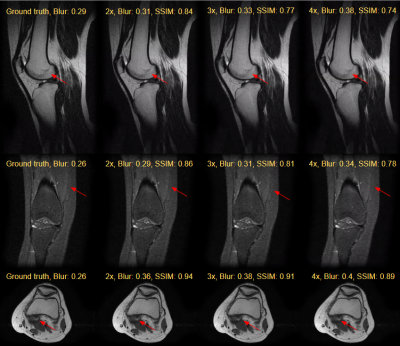 |
5131. Up
to four times accelerated musculoskeletal MRI at 0.4T using the
CIRIM-network
D. van den Berg, R. Varriale, F. Ferrando, P. Traverso, L.
Balbi, G. Strijkers, M. Caan
Amsterdam UMC, Amsterdam, Netherlands
Impact: Low-field MRI is cost-effective and can
therefore increase the worldwide accessibility of MRI. By
accelerating imaging using deep learning reconstruction on
undersampled data, we realize time-efficient scanning.
|
|
| 5132. WITHDRAWN | ||
 |
5133. An
Algorithm for Detecting Short-Lived Motion-Induced Corruption in
k-Space
T. Höpfner, F. Werner, T. Wech, H. Köstler
University of Würzburg, Würzburg, Germany
Impact: We propose a method to automatically detect
k-space lines, corrupted by patient motion, using a
multiscale scanning statistic, allowing to replace these
data in optimized reconstructions.
|
|
 |
5134. Reducing
aliasing-induced artifacts in BLADE sequence using extended-FOV
reconstruction
K. Zhou, N. Xiao, L. Yang
Siemens Shenzhen Magnetic Resonance Ltd., Shenzhen, China
Impact: The extended-FOV method can be integrated
seamlessly into the existing scanning process without
requiring additional scan time, to effectively eliminate
aliasing-induced artifacts.
|
|
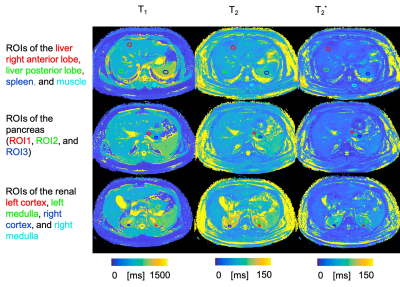 |
5135. A
Rapid Free-Breathing Whole-Abdomen Scan for Simultaneous T1, T2,
and T2* Mapping Across Abdominal Organs
M. K. Manhard, A. Kilpattu Ramaniharan, J. Greer, J. Tkach,
A. Trout, J. Dillman, A. Pednekar
Cincinnati Children's Hospital Medical Center, Cincinnati, United States
Impact: This study demonstrates that a single
one-minute, free-breathing MI-SAGE scan can achieve T1,
T2,
and T2* estimates
across abdominal organs, comparable to published values and
consistent with liver and muscle values from conventional
mapping techniques from multiple breath-hold scans.
|
|
 |
5136. Evaluating
how far we can minimize MP2RAGE acquisition time with compressed
sensing
I. KIDA
National Institute of Information and Communications Technology, Suita, Japan
Impact: The significant scan time reduction obtained by
CS-MP2RAGE sequence could improve clinical and experimental
workflow efficiency, reduce patient discomfort, and expand
research possibilities in ultra-high-field MRI.
|
|
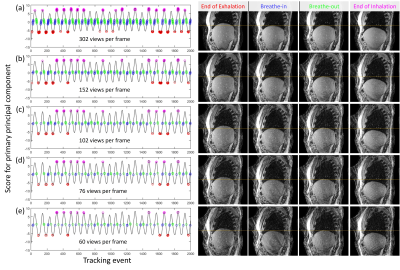 |
5137. Surface
Tracking-assisted Real-time 4D Lung MRI
X. Liang, L. Pan, E. Nevo, H. Soomro, S. Roys, R.
Gullapalli, A. Sawant, T. Ernst, J. Zhuo
University of Maryland School of Medicine, Baltimore, United States
Impact: Continuous 4D lung MRI allows accurate modeling
of respiration-induced internal target motion to surface
motion prior to radiotherapy, and thus enables real-time
target tracking during external beam radiation treatment
without the need of MR linac.
|
|
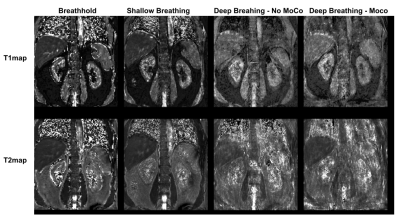 |
5138. Motion-Robust
T1/T2 Mapping of the Abdomen using Pilot-Tone Navigation
C. Ariyurek, B. Bilgic, S. Fujita, Y. Jun, S. Kurugol, B.
Gagoski, O. Afacan
Boston Children's Hospital and Harvard Medical School, Boston, United States
Impact: We introduce a motion-robust technique for
high-resolution T1/T2 mapping of the kidneys using 3D-QALAS
with pilot-tone-navigation. By overcoming respiratory motion
challenges, this method could improve the accuracy and
clinical applicability of quantitative renal MRI, enabling
earlier detection of kidney diseases.
|
The International Society for Magnetic Resonance in Medicine is accredited by the Accreditation Council for Continuing Medical Education to provide continuing medical education for physicians.